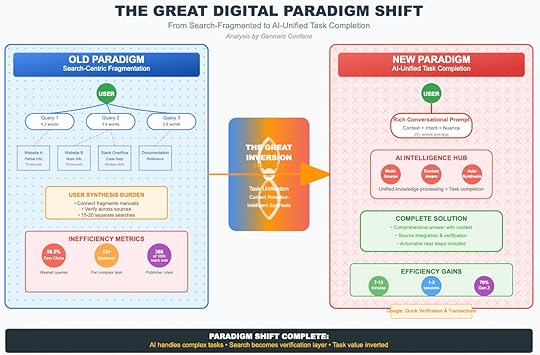The Great Digital Paradigm Shift

For over two decades, the digital economy has been built on search. The model was simple: users typed queries, scanned results, clicked links, and pieced together answers. Google sat at the center of this system, extracting value from billions of fragmented searches every day.
But that model is breaking. AI is rewriting the logic of digital interaction, shifting us from search-fragmented workflows to AI-unified task completion. This change isn’t incremental — it’s a paradigm shift.
The Old Paradigm: Fragmentation and BurdenIn the search-centric era, the burden of synthesis fell squarely on the user. A typical journey looked like this:
Multiple Queries. Users rephrased questions (average 3–5 queries per task).Fragmented Sources. Each click yielded partial answers — a snippet here, a reference there.Manual Synthesis. Users stitched fragments together, verified sources, and reconciled contradictions.This created a hidden tax on productivity. Research showed:
12+ searches were required for most complex tasks.58.5% of queries ended in zero clicks, signaling wasted effort.Out of 1,000 sites on the web, only 360 captured meaningful traffic, leaving the long tail starved.The result was a paradox: endless information, but high cognitive load for the user and inefficient discovery for businesses.
The Great InversionAI introduces an inversion of this dynamic. Instead of users doing the work of synthesis, AI agents handle unification, context retention, and intelligent synthesis.
The shift can be summarized in three words:
From Search → To ConversationFrom Fragmentation → To IntegrationFrom Burden → To CompletionThis is not about improving the old model. It’s about replacing the very mechanics of how digital knowledge is accessed and applied.
The New Paradigm: AI-Unified Task CompletionIn the AI paradigm, the process begins not with fragmented queries but with a rich conversational prompt. Users provide intent, context, and nuance in a single interaction.
That input flows into an AI Intelligence Hub with three core capabilities:
Multi-Source Processing. Pulling from multiple databases, documents, and knowledge graphs simultaneously.Context Awareness. Retaining memory of prior prompts, user preferences, and task progression.Auto-Synthesis. Delivering unified answers — not fragments — that integrate sources and recommend next steps.The outcome is a complete solution:
Comprehensive, contextual answersIntegrated verification across sourcesActionable recommendations or transactionsWhat once required 15–20 searches can now be resolved in one or two sessions.
Efficiency Gains: Time, Sessions, SatisfactionThe efficiency impact is profound:
Time Reduction. Complex research tasks shrink from 15–20 minutes to 7–13 minutes.Session Compression. Instead of multiple queries across platforms, users resolve needs in 1–2 AI sessions.Behavioral Shift. Among Gen Z, 70% now prefer AI interactions for discovery over traditional search engines.In short: search is no longer the destination. It is becoming the verification layer.
Strategic ImplicationsThe implications of this shift ripple across the digital ecosystem.
1. For UsersCognitive load collapses. Tasks that once required managing tabs, juggling sources, and synthesizing information now resolve in a single conversational loop. The user becomes consumer of outcomes, not processor of fragments.
2. For BusinessesVisibility dynamics are inverted. Brands can no longer rely on SEO alone to surface in fragmented search. Instead, they must ensure AI systems can cite them as authoritative sources. Structured data, direct integrations, and knowledge graph strategies become critical.
3. For PlatformsThe economics of the web shift. Google’s role transitions from orchestrating discovery to validating AI outputs and enabling transactions. The monetization logic will follow — from click-based advertising to value capture at the verification and transaction layers.
The Paradigm Shift CompleteWe are not speculating about the future. The shift is already underway. Users are adopting AI-first behaviors, Gen Z is bypassing search altogether, and businesses are confronting declining traffic from traditional funnels.
The new digital paradigm can be summed up in three points:
AI handles complex tasks.Search becomes verification, not discovery.Task value is inverted — completion, not clicks, defines success.Preparing for the InversionTo thrive in this paradigm, organizations must adapt quickly. The roadmap includes:
AI-Ready Content. Publish structured, citable knowledge that AI agents can parse.Conversational Interfaces. Build direct AI channels to engage customers.Verification Strategy. Position your brand as the source AI validates against.The winners will not be those with the most traffic, but those with the most trust in AI-mediated ecosystems.
Final WordThe Great Digital Paradigm Shift is not just technological. It’s cognitive and economic. For the first time since the birth of the web, the burden of synthesis is leaving the user.
This inversion will define the next decade: an era where tasks are unified, context persists, and completion replaces fragmentation.
The companies that recognize this early will shape the future. The rest will be optimized out of existence — not by competitors, but by the very AI agents their customers now trust.

The post The Great Digital Paradigm Shift appeared first on FourWeekMBA.



